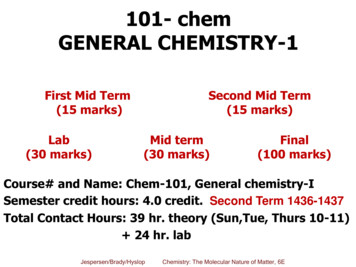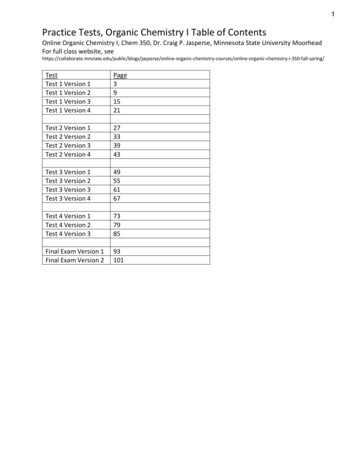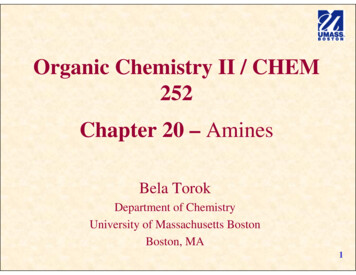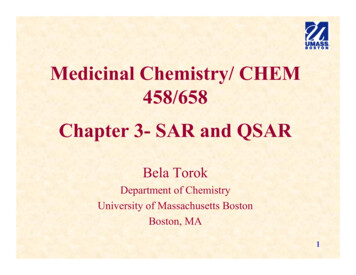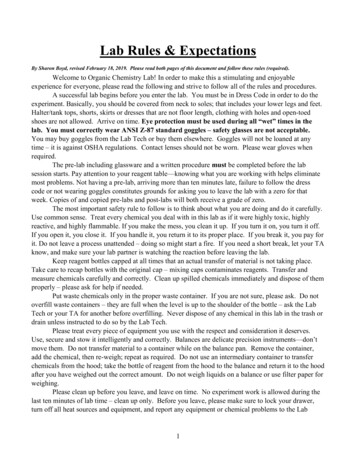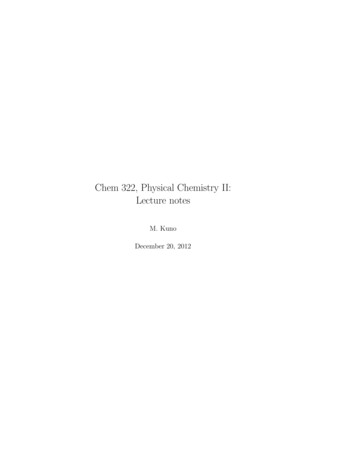
Transcription
Chem 322, Physical Chemistry II:Lecture notesM. KunoDecember 20, 2012
2
Contents1 Preface12 Revision history33 Introduction54 Relevant Reading in McQuarrie95 Summary of common equations116 Summary of common symbols137 Units158 Math interlude219 Thermo definitions3510 Equation of state: Ideal gases3711 Equation of state: Real gases4712 Equation of state: Condensed phases5513 First law of thermodynamics5914 Heat capacities, internal energy and enthalpy7915 Thermochemistry11116 Entropy and the 2nd and 3rd Laws of Thermodynamics123i
iiCONTENTS17 Free energy (Helmholtz and Gibbs)15918 The fundamental equations of thermodynamics17919 Application of Free Energy to Phase Transitions18720 Mixtures19721 Equilibrium22322 Recap25723 Kinetics263
Chapter 1PrefaceWhat is the first law of thermodynamics?You do not talk about thermodynamicsWhat is the second law of thermodynamics?You do not talk about thermodynamics1
2CHAPTER 1. PREFACE
Chapter 2Revision history2/05: Original build11/07: Corrected all typos caught to date and added some more material1/08: Added more stuff and demos. Made the equilibrium section morepedagogical.5/08: Caught more typos and made appropriate fixes to some nomenclaturemistakes.12/11: Started the next round of text changes and error corrections sinceI’m teaching this class again in spring 2012. Woah! I caught a whole bunchof problems that were present in the last version. It makes you wonder whatI was thinking. Anyway, hindsight is 20/20.12/12: Made next round of error corrections as caught by students duringthe spring semester of 2012. Made some other minor text changes andcorrections. Also changed one derivation for the boiling point elevation inthe colligative properties section.3
4CHAPTER 2. REVISION HISTORY
Chapter 3IntroductionThis is left here for posterity (outdated)Chem. 322 Physical Chemistry 2 MWF 11:45-12:35 Fitzpatrick 356Instructor: Ken Kuno 146 Stepan Chemistry mkuno@nd.eduGrader: Chuck Vardeman Charles.F.Vardeman.1@nd.eduOffice hours: T,Th 11:45-12:35Class requirementsroughly 10 problem sets 3 exams and 1 finalProposed grading schemeProblem sets 10%Exams 20%Final 30%Foreword to the studentTo quote Gilbert Castellan from his well known textbook “Physical chemistry”:“On most campuses, the course in physical chemistry has a reputationfor difficulty. It is not, nor should it be, the easiest course available; but tokeep the matter in perspective, it must be said that the IQ of a genius isnot necessary for understanding the subject. . . Finally, don’t be put off bythe reputation for difficulty. Many students have enjoyed learning physicalchemistry.” (this guy must have a sense of humor)5
6CHAPTER 3. INTRODUCTIONNow this is me speaking:Unfortunately, this is an old, yet important, field. There have been manymany people who have contributed things in this area over literally 200years. As a consequence, there is some kind of name equation for justabout everything. For example, the Carnot cycle, Joule-Thompson expansion, Helmholtz free energy, and the Gibbs (not the Redskins coach) freeenergy (even though in some cases, one name equation is just a derivative ofanother). Other prominent names you will see come up include Kelvin (orLord Kelvin in some books), Clausius etc. I kid you not, it will be hard tokeep track of all these people and associated name equations. But I’d likeyou to consider the following quote by Poincare.“The order in which these elements are placed is much more importantthan the elements themselves. If I have the feeling. . . of this order, so as toperceive at a glance, the reasoning as a whole, I need no longer fear lest Iforget one of the elements, for each of them will take its alloted place in thearray, and that without any effort of memory on my part”Understand what you are doing and more importantly why. This willhelp you put this course into perspective. I will also try to weave a storythrough the course to help you remember the flow of ideas. I don’t know ifyou are old enough to have watched Battlestar Galactica on TV but therewas this one episode where Starbuck (I think) teaches a group of kids onsome planet how to carry out some plan against the cylons by rememberingwords to a song. It’s the same sort of idea here.I encourage everyone to work problems, the more the better. It willhelp you put the concepts being discussed on a firmer basis. There is asaying that goes “If you’re going to talk the talk, you gotta walk the walk”.You will discover that I have an unusual affinity for this quote. Also, whenworking problems, be aware of your problem’s environment. Know exactlywhat conditions and assumptions are being made (constant volume, constantpressure, temperature etc. . . ). There are too many ways you can go wrongif you don’t know what you need to do and more importantly what sort ofequation you have to use.Get a scientific calculator and become familiar with how to use it. I hadone HP-21S calculator for over ten years since my undergrad days. Thisthing was solid. Sadly they don’t build things like they used to anymore somy new HP from Walmart feels pretty cheap. Also because thermodynamics,in particular, is an old field people like to work in old units. So units likethe atmosphere or millimeters of mercury or bar are more common than SIunits. However, you must be ready to convert between the two with ease.This will come with practice.
7Finally, last but not least, four important points. This is the first (nowsecond) time that I have taught this course and more specifically, taught toundergraduates. Please bear with me while I get my feet wet (still applies).Second, I will try and post my class notes on my web page. You can thendownload them from there. There is a chance that I will just print them outand hand them out each time but this will depend on how hectic the semesterbecomes. Third, although the textbook for this class is McQuarrie, I havenever used McQuarrie for thermodynamics, or kinetics and upon glancingthrough the material decided that I didn’t like how he presented things(still true). Just be aware that I may be coming from left field relative toMcQuarrie on some days. Finally, I encourage everyone to look at differenttext books. Sometimes one author will confuse you and another will explainit differently in a clear manner. This applies to me as well. A little outsidereading goes a long way.Now why botherHere we discuss why one studies thermodynamics (and kinetics and statistical mechanics). Quantum mechanics and thermodynamics are two pillarsof chemistry. Quantum as you have just seen is concerned with the microscopic properties of atoms, molecules. In fact, if you think about it all theproblems you have worked in quantum, whether it be the particle in a box,the harmonic oscillator, the rigid rotor deals with one box, one oscillator,one rotor. This is the single atom, single molecule limit. From these modelsystems you found the electronic energies of the system, the vibrational androtational energies. You also found the wavefunctions whether you reallycared about them or not. You may even have (don’t know how far yougot, actually I do since I taught 321 last semester) have modeled transitionsbetween these levels using time dependent perturbation theory.Thermodynamics, on the other hand, deals with ensembles or macroscopic quantities of matter. We’re talking Avogadros number of atoms ormolecules. It deals with energy conservation and energy transfer (the conversion between energy in its different forms such as kinetic energy andpotential energy and its exchange from one body of matter to another),such as in chemical reactions. More importantly from a practicing chemist’spoint of view it predicts the spontaneous direction of chemical reactionsor processes. Hey, if you mix A and B together do they react? Wouldn’tyou like to know beforehand? However, it does not presume a microscopicpicture of molecules or atoms. In this sense thermodynamics is a self con-
8CHAPTER 3. INTRODUCTIONsistent field. Recall that thermodynamics was developed a long time ago inthe context of engineers, inventors and others trying to make better steamengines or hot air balloons. But the results were so general that it workedwith chemistry and physics as well.Although thermodynamics tells you if something can happen it saysnothing about how fast the process occurs. You don’t know the rate ofthe process. This is the realm of chemical kinetics which we will discussafter establishing the basic principles of thermodynamics. Finally tyingthe macroscopic and microscopic pictures of matter together is the field ofstatistical mechanics. It uses statistical principles and a quantum mechanicalview of atomic and molecular energy levels to tell you why a macroscopicthermodynamic quantity takes the value that it does.Finally you should be aware that there are a number of approaches forteaching thermodynamics. One approach (I’ll call it the classical approach)just teaches you the fundamental laws of thermodynamics, the behavior ofgases, liquids and solids (without specifying any details of the system). Youthen do kinetics and usually there is a separate class for statistical mechanics (if any). The other tries to teach thermodynamics from a statisticalmechanics approach (this is what McQuarrie is trying to do).
Chapter 4Relevant Reading inMcQuarrie Math review: pg 683-689 Ideal gas equation of state: Ch.16, pg 637-642 Real gas equation of state: Ch. 16, pg 642-648 1st Law of Thermodynamics:Hess Law and thermochemistry Ch. 19, pg 765-800 (Ignore 19-6) Entropy and the 2nd Law of Thermodynamics, Ch 20, pg 817-844(Ignore 20-5, 20-8, 20-9) Entropy and the 3rd Law of Thermodynamics, Ch 21, pg 853-870,(Ignore 21-6) Spontaneity and Gibbs free energy, Ch 22, pg 881-910 Single component phases, Ch. 23, pg 925-945, (Ignore 23-5) Mixtures, Ch. 24, pg 963-998 Equilibrium, Ch. 26, pg 1049-1087, (Ignore 26-8, 26-9) Kinetics, Ch. 29, pg 1181-1213, (Ignore 29-7) Statistical mechanics, series and limits, MathChapter I, pg 723-726 Statistical mechanics, Stirlings approximation, MathChapter J, pg809-8139
10CHAPTER 4. RELEVANT READING IN MCQUARRIE Statistical mechanics, Boltzmann, Ch. 17, pg 693-716 and Section20-5, pg 829-832 Statistical mechanics, partition functions, ideal gases, Ch. 18, pg 731756
Chapter 5Summary of commonequations Boyle’s Law, Pressure/Volume inverse relation Charles’ Law, Volume/Temperature direct relation Ideal gas Law, Boyle and Charles Laws put together, pv nRT Dalton’s Law, partial pressures of ideal gas, ptot p1 p2 or more ifgreater that 2 components PV work (w), gas expansion work due to volume change against anexternal pressure Heat (q), the name says it all 1st Law of thermodynamics, Basically conservation of energy, U q w Joule-Thompson coefficient, associated with Joule expansion and changeof temperature with change of pressure Enthalpy, H U pV Hess’ Law, Thermochemistry and enthalpy bookkeeping Kirchoff’s Equation, Get enthalpy at different temperatures throughCp no-name1, Get internal energy at different temperatures through Cv11
12CHAPTER 5. SUMMARY OF COMMON EQUATIONS Fundamental equations of thermodynamics, Remember “Save thatship Gibbs”, you’ll see Maxwell’s Relations, a consequence of the above Gibbs free energy, G H T S or G A pV , constant Pressure andTemperature Helmholtz free energy, A U T S, constant Volume and Temperature Gibbs-Helmholtz equation, temperature dependence of G no-name2, pressure dependence of G Clapeyron equation, solid/liquid line in a phase diagram Clausius-Clapeyron equation, liquid/vapor line in a phase diagram(basically an extension of the Clapeyron equation) Trouton’s Rule, S for many systems HvapTbat liquid vapor line, nearly const value Gibbs-Duhem equation, The chemical potential of components in amixture are not independent. Raoult’s Law, relation between partial pressure of components in amixture with its mole fraction Henry’s Law, corrected Raoult, take that! Le’Chatelier’s Principle, more products or reactants by varying pressure, temperature, concentration etc. Van’t Hoff Equation, describes variation of the equilibrium constant.It is also basically the Gibbs Helmholtz equation.As you are going through the course, periodically look through this section to help you remember these equations. Also if I have missed an equationjust add it by hand here.
Chapter 6Summary of commonsymbols q, heat w, work p, pressure V , volume n, moles T , temperature Cp , constant pressure, heat capacity Cv , constant volume, heat capacity U , internal energy H, enthalpy G, Gibbs free energy A, Helmholtz free energy S, entropy µ, chemical potential f , fugacity13
14CHAPTER 6. SUMMARY OF COMMON SYMBOLS a, activity χ, mole fraction
Chapter 7UnitsPressureThe SI unit of pressure is Pa (Pascal)P a N/m2 J/m3 kg/ms2Misc. unitsJJNJm2s2 N ·mkg · m s2 P a · m3 kg ·More common unitsCommon (practical) units of pressure are atm (atmosphere), basically you live at 1 atm pressure torr mm Hg (millimeters of mercury) bar15
16CHAPTER 7. UNITSPressure in Everyday LifeSo that you are calibrated in terms of pressures, here is a list that I foundon a BBC website. 10-20 atm - The pressure in space-vacuum 10-16 atm - The lowest pressure ever achieved by a man made gizmo 10-6 atm - Ordinary vacuum pumps 10-2 atm - The pressure in a common light bulb 0.5 - 1.5 atm - Atmospheric pressure 1.5 - 2.4 atm - Car tyres 3 - 7 atm - Flatus (!) 4 - 12 atm - Bicycle tyres 10 atm - The pressure inside the cylinder cavity in a car’s engine 100 - 500 atm - Compressed gas cylinders 500 atm - The impact pressure of a karate fist punch (so what wouldChuck Norris’ value be?) 1000 atm - The pressure at the bottom of the Mariana Trench 7000 atm - Water compressors 106 atm - The pressure at the centre of the earth, and also the highestpressure ever achieved by a man-made machine (diamond anvil) 1011 atm - The pressure at the centre of the sun -enough to ignitefusion reactions Approx. 1029 atm - The pressure at the centre of a neutron star.Unit conversion 1 atm 1.01325 105 Pa 1 atm 760 torr 1 atm 760 mm Hg
17 1 atm 1.01325 barwhere 1 mm Hg 1 Torr 1 bar 105 PaVolumeThe SI unit of volume is the cubic meter (m3 ). Of course this means thatno one uses this.More common unitsCommon (practical) units of volume are cm3 (aka “cc” where 1 cc 1 mL in case you watch these medicalshows on TV) dm3 L, litersUnit conversion 1 L 1dm3 1 L 1000cm3 1 L 1 10 3 m3TemperatureThe SI unit of temperature is Kelvin (K). Sometimes you will see Celsius.But it’s more common to use Kelvin.K C 273.15(7.1)
18CHAPTER 7. UNITSIdeal gas constant, R R 8.314J/mol · K, this is very commonly used R 0.08206L · atm/mol · K, this is also very commonly used R 8.314kg · m2 /s2 · mol · K R 8.314kP a · dm3 /mol · K R 1.9872cal/mol · K R 0.083145L · bar/mol · KEnergy 1 cal 4.18 J 1 kcal 4.18 kJ JoulesDemoA demo can be shown here by burning donuts or burning potato chips andheating a water bath and watching the temperature change. Pringles burnfairly cleanly. Doritos don’t burn as well. If you’re going to do this, Irecommend using a hood.Some examples of unit conversionTo get warmed up, convert the followingExample 1Calculate R in terms of calories starting with R 8.314J/mol · K.Ans:1cal 4.184JBy the way 1 real world “calorie” is actually 1 scientific kcal. So if you everwatch the movie “Supersize me” you will see that our health officials haveforgotten their units. No wonder we’re so huge.
198.314 1.9871cal/mol · K4.184R 1.9871cal/mol · KExample 2Calculate R in terms of bar and L starting with R 8.314J/mol · KAns: 1Joule 1P a · m3 We haveR 8.314P a · m3 /mol · KNow recall that 1P a 10 5 bar. We now haveR 8.314 10 5 bar · m3 /mol · Kwhere 1m3 1000L. Now we getR 8.314 10 2 bar · L/mol · KThe desired answer isR 0.08314bar · L/mol · KExample 3Calculate R in terms of L · atm starting with R 8.314J/mol · K.Ans: J P a · m3 givingR 8.314P a · m3mol · Kwhere 1.01325 105 P a 1atm or 1P a 9.87 10 6 atm. This givesR 8.314(9.87 10 6 )atm · m3 /mol · Kwhere 1m3 1000L giving8314(9.87 10 6 )L · atm/mol · KR 0.08206L · atm/mol · K
20CHAPTER 7. UNITS
Chapter 8Math interludeExact or total differentialsThese types of differentials are important because they illustrate the idea ofpath independency. This is an important concept when working with thermodynamic functions such as energy, enthalpy and entropy. These thermodynamic functions are called state functions and they are said to depend onlyon the initial and the final state of the system and not the path traversedin going from one to the other.Assume a function of two variables f (x, y). In reality, this could be afunction depending on actual variables [say (V , T ), (P , T ) etc.]. Now thetotal differential of this function f (x, y) is written as fdf fdx dy(8.1) x yyxwhere the subscripts x and y refer to keeping x or y constant while differentiating. The total differential describes how the function f will changewhen both x and y change. The homework will include an example thatwill better drive home this point in a physical way. f fNow, since x and y are functions of x and y one may also writedf M (x, y)dx N (x, y)dy.If we form second derivatives of the function f (x, y) there are several possibilities. For example, f x can be differentiated with respect to either x or y. Likewise f y can be differentiated with respect to either x or y. Wethen get the following second derivatives21
22CHAPTER 8. MATH INTERLUDE 2f x2 2f x y 2f y2 2f y xHowever, of these four terms only three are actually distinct. In this respect,it can be shown that for a function of several variables that the order ofdifferentiation with respect to 2 variables such as x, y does not matter andthat 2f 2f x y y xor that M y N x 2f y x 2f x yand that M N . y xThese are important tests of what is called exactness. We will use thislater in deriving what are referred to as Maxwell’s relations (no, not theElectricity and Magnetism ones).Now conversely a differential expressionM (x, y)dx N (x, y)dyis called an exact differential if it happens to correspond to the total differential of some function f(x,y). Let’s say you don’t know f(x,y) a priori.Then to check, the necessary condition for this random differential to beexact is if M N . y x
23ExampleThe state of a thermodynamic system is generally a function of more thanone independent variable. Generally, many thermodynamic problems youwill encounter involve only two independent variables (P ,T ) or (V ,T ) etc. . .Consider the case of an ideal gas where, without deriving it yet and simplyasking you to remember Freshman chemistry -this is the ideal gas equation),pVVVV nRT f (T, p)nRT pRT(n 1). pV can therefore be written as a function of T and p since R is a constant.Its total or exact differential is V VdV dp dT p T T pwhich explicitly shows its dependenceon p and T . V VNow let’s evaluate pand T p. We getT VRT 2 p Tp VR T ppgivingdV R RTdP dT2ppYou can now check for exactness in your leisure time.Math gamesOften in thermodynamics there will be no convenient experimental methodfor evaluating a dependency (i.e. derivative needed for some problem). Inthis case, we can play some math games to get what we want.
24CHAPTER 8. MATH INTERLUDEExampleStart with the total differential for V f (p, T ) V VdV dp dT p T T p pSay you want or need T. To obtain this dependency, divide both sidesVby dT and keep V constant (i.e. dV 0). Vdp VdV 0dT V p T dT V T pSince dV 0, we have p T V V T p V p ,Twhich is the expression we were after. Note that the numerator on the rightis related to what is called the coefficient of thermal expansion (α) while thedenominator is related to what is called the coefficient of compressibility(κ).ExampleNext, starting with the same total differential above V VdP dTdV p T T p say you want T. To obtain this, divide by dp and keep V constant (i.e. pVdV 0). We get dV V VdT 0,dp V p T T p dp Vresulting in T p which is our desired expression.V V p T V T p,
25Example, the inverterFrom the previous two results we can then see that p1 . T T V pVThis relationship has a name in some texts and is called the “inverter”.Generally speaking then x y z 1( y x )z.(8.2)Example, the cyclic rule or Euler chain relationAnother useful relation between partial derivatives is called the cyclic rule.The total differential of a function is written (again) as z zdz dx dy 0 x y y xthis time using z f (x, y). Furthermore, as before, we restrict the previousequation to those where variations of x and y leave the value of z unchangedz(x, y) constant or conversely (dz 0). z zdx dy 0. x y y xDividing by dy and keeping z constant, we get z x z 0 x y y z y x At this point, multiply by y z x , using our previous inverter relation, toget y z x 1 0. z x x y y zThis yields our final result x y z y z x z x y 1 .(8.3)
26CHAPTER 8. MATH INTERLUDENote that it can also be shown that x z y 1. z y y x x zThis is useful since x,y,z in the numerator are related the y,z,x in the denominator as well as to the associated subscripts by a cyclic permutation.Since in many thermodynamic situations the variables of state are functionsof 2 other variables there is frequent use of such relations.You don’t have to memorize this equation. Just write down x,y,z in thenumerator in any order. Usually just keep the x,y,z order. Then underneathin the denominator write down x,y,z in any order but do not repeat the thesame letter in both the numerator and denominator. You will find that thereare only two unique combinations (those shown above).SummaryRelation 1 f x z f x y f y x y x (8.4)zRelation 2 (the “inverter”) x y z 1(8.5) y x zRelation 3 (the “permuter”) x y z x z y z y (8.6)xRelation 4 (the “Euler chain relation”) x y z y z x z x y 1(8.7)
27Solving the differentialGiven the total differential for f (x, y) f fdx dydf x y y x M dx N dyits functional form can be found in the following systematic fashion.From f x M integrate to getf ZM dx k(y)where k(y) is some constant that potentially depends on y. The next stepis to find out what k(y) is by differentiating this expression with respect toy. Z f d M dx k(y) N (x, y). y x ydyNow we rearrange and find k(y) by integratingdk(y) N (x, y) dy y Zdk(y)dyM dx M dx to getk(y) ZN (x, y)dy Z dy y Z const.Replace this k(y) into our previous expression for f to get what we wereafter Z ZZZ M dx const.f (x, y) M dx N dy dy yExampleSolvedf (x3 3xy 2 )dx (3x2 y y 3 )dy 0.
28CHAPTER 8. MATH INTERLUDETest for exactnessM (x, y) x3 3xy 2N (x, y) 3x2 y y 3taking their cross derivatives we get M 6xy y N 6xy xHence the equation is exact. Now, we go after f (x, y)Zf M dx k(y)Z (x3 3xy 2 )dx k(y)x4 3y 2 x2 k(y).42 Find k(y) by differentiating this, keeping x constant f y x6yx2 dk(y) N (x, y)2dyTherefore, we have the equivalence6yx2 dk(y) 2dydk(y)dy 3x2 y y 3 y3yieldingk(y) y4 const4Put it all together now.f (x, y) x4 3x2 y 2 y 4 const424
29Integrating factorsThe idea behind this method is simple. We sometimes have an equationp(x, y)dx q(x, y)dy 0that is not exact. However, if we multiply it by some suitable function f(x,y),the new equationf pdx f qdy 0is exact so that it can be solved like we did before. Our job here is to findthis integrating factor f (x,y).In simple cases, f (x, y), can be found by inspection but more generallydo the following. Sincef pdx f qdy 0is exact f q f p y xIn general, this is complicated. Therefore make some simplifications andlook for an integrating factor that depends only on one variable. Thus letf f (x).f p f q f p f q y y x xwhere the second term on the left is zero because f has no y dependence.We then getf p q f f q y x xDivide through by f q to get1 p1 q1 f q yq x f xNow consolidate terms to get1 ff x lnf 1qZ p q y x 1 p q dxq y x
30CHAPTER 8. MATH INTERLUDEThe desired integrating factor is thereforeRf e1q“ p q x y”(8.8)Note that the same type of argument can be made if one assumes f f (y)only rather than f f (x) as done here.Linear differential equationsThis section is mostly for the kinetics part of this course.A 1st order differential equation is said to be linear if it can be written0y p(x)y r(x)0The characteristic feature of the equation is that it is linear in y and ywhereas p and r on the right may be any function of x.Now if r(x) 0 the equation is said to be homogeneous. If r(x) 6 0then this is a non-homogeneous equation.Homogeneous caseFor example0y p(x)y 0dy p(x)ydxdy p(x)dxyZlny p(x)dx constresulting iny Ae Rp(x)dxwhere A is a constant. This is the desired general solution for the homogeneous case.
31Non-homogeneous caseConsider the same equation0y p(x)y r(x)This will be solved by using an integrating factor. Rewrite the expressionasdy p(x)y r(x) 0dxdy (p(x)y r(x))dx 0(p(x)y r(x))dx dy 0P dx Qdy 0whereP p(x)y r(x)Q 1From our integrating factor formula derived previously1 dff dx1 dff dx1 dff dx1 dff dxdfflnff 1 p q q y x 1 (p(x)y r(x)) 01 y [p(x)y r(x)] y p(x)Z p(x)dxZ p(x)x constR Aep(x)dxor if A 1Rf (x) ep(x)dx
32CHAPTER 8. MATH INTERLUDEThis is our desired integrating factor. Now multiply our original equationby this integrating factor to make it exact.0f (x)[y p(x)y] f (x)r(x)RepdxR0(y py) e pdxr(x) R 0Re pdx e pdxr(x)You can check for yourself that the last expression is true.R R 0Rd R pdx d( pdx)pdxpdx 0e ey y (e)dxdxRRpdx 0pdx ey yepR epdx0(y yp)So you can see that the expression checks out.Back to where we left off R 0Re pdx e pdx r(x)Integrate this with respect to xZ RRpdxey e pdxr(x)dx constgiving y eRpdx ZRepdx r(x)dx constThis is our desired final solution. The choice of constant does not matter.ExampleNonhomogeneous 1st order linear differential equation.Solve the following linear differential equation.0y y e2xHerep(x) 1r(x) e2x
33Solve for the exponential termRpdxeR e 1dx e xWe haveRepdx e xPlug this into the general formula for the integrating factor. Z R R pdxpdxy eer(x)dx const Zx xe r(x)dx const e Z exe x e2x dx const Z xx ee dx const ex [ex const]Our general solution to the problem is thereforey Cex e2xwhere C is a constant.
34CHAPTER 8. MATH INTERLUDE
Chapter 9Thermo definitions System: the system is the part of the world in which we have a specialinterest. It may be a reaction vessel, an engine, an electrochemical cell,a biological cell, etc. Surroundings: everything else Open system: if matter can be transferred through the boundarybetween the system and its surroundings Closed system: matter cannot pass through the boundary betweenthe system and its surroundings. Both open and closed systems, however, can exchange energy with their surroundings. We will primarilydeal with closed systems in this class.Within closed systems we have two subclasses Isolated system: This is a closed system and on top of it, no mechanical or thermal energy can be exchanged between system and surrounding. This is boring and we will generally not be interested inthis. Adiabatic system: This is also a closed system, but absolutely nothermal energy can be exchanged between the system and surrounding.However mechanical work or energy can be transfered (unlike the pureisolated system).Some important processes as we move from some initial state of a systemto a final state are characterized by holding a quantity constant during theprocess:35
36CHAPTER 9. THERMO DEFINITIONS isobaric means p 0 isothermal mean T 0 isentropic means S 0 isometric means V 0 adiabatic means dq 0Pictorial representationsI guess one day I’ll add these drawings.
Chapter 10Equation of state: Ideal gasesA system is in a definite state when all of its properties (e.g. mass, pressure,volume, temperature, etc.) have definite values. The state of the system istherefore described by specifying the values of some or all of its properties.The question we ask is whether you need to specify 5, 20, 50, 100, different properties to ensure that the state is completely described. Fortunatelyonly four properties, mass, volume, temperature, and pressure are ordinarilyrequired.The equation of state is the mathematical relationship between the valuesof these four properties. Unfortunately, of solids, liquids and gases, only thegas phase allows for a simple quantitative description of the equation ofstate.Ideal gas equationAn ideal gas is defined as one in which all collisions between point particles(in reality, atoms or molecules but idealized here to be particles which occupyno volume) are perfectly elastic (no loss of energy on collision) and in whichthere are no intermolecular interactions whether attractive or repulsive. Onecan therefore visualize the ideal gas as a collection of infinitesimally smallhard spheres which collide but which otherwise do not interact with eachother. In such a gas, all the internal energy is in the form of kinetic energy and any change in internal energy is accompanied by a change in thetemperature of the gas. Note that we say nothing about what this internal energy actually is. In fact, classical thermodynamics doesn’t care. Butyou know from your previous classes that this internal energy is basicallythe rotational and vibrational energies of the system’s constituent atom
Chem. 322 Physical Chemistry 2 MWF 11:45-12:35 Fitzpatrick 356 Instructor: Ken Kuno 146 Stepan Chemistry mkuno@nd.edu Grader: Chuck Vardeman Charles.F.Vardeman.1@nd.edu Office hours: T,Th 11:45-12:35 Class requirements roughly 10 problem sets 3 exams and 1 final Proposed grading scheme Pro
